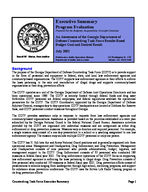Russell W. Hinton, State Auditor
Executive Summary
Program Evaluation
Prepared For the Budgetary Responsibility Oversight Committee
An Assessment of the Georgia Department of Defense Counterdrug Task Force Results-Based Budget Goal and Desired Result
July 2002
Performance Audits Operations Division Department of Audits and Accounts
254 Washington St., S.W. Atlanta, GA 30334-8400
Background
The purpose of the Georgia Department of Defense Counterdrug Task Force (CDTF) is to provide support in the form of personnel and equipment to federal, state, and local law enforcement agencies and community-based organizations. The CDTF supports law enforcement agencies in their efforts to enforce the laws pertaining to the sale and manufacture of illegal drugs and supports community-based organizations in their drug prevention efforts.
The CDTF operates as a unit of the Georgia Department of Defense Joint Operations Directorate and has been operational since 1989. The CDTF is entirely funded through federal funds and drug asset forfeitures. CDTF personnel are federal employees, and federal regulations establish the operational parameters for the CDTF. The CDTF Coordinator, appointed by the Georgia Department of Defense Adjutant General, manages day-to-day operations. CDTF headquarters are located at Dobbins Air Reserve Base, and CDTF personnel conduct missions throughout Georgia.
The CDTF provides assistance only in response to requests from law enforcement agencies and community-based organizations. Assistance is provided based on the priorities established in a state plan submitted by the Georgia National Guard to the federal National Guard Bureau. Assistance activities provided by the CDTF are organized into individual missions and are categorized as either drug enforcement or drug prevention missions. Missions vary in duration and required personnel. For example, a single mission may consist of a one-day presentation to a school or a yearlong assignment to one law enforcement agency. The mission may include multiple CDTF personnel or only one person.
The CDTF has 51 full-time Air and Army National Guard positions and is generally organized into three operational areas: Management and Headquarters, Drug Enforcement, and Drug Prevention. Management and Headquarters consists of nine personnel who provide administrative, budget, logistics, and management support to the CDTF. Drug Enforcement consists of 37 personnel who conducted 186 missions in federal fiscal year 2001. The drug enforcement operations of the CDTF focus on supporting law enforcement agencies in enforcing the laws pertaining to illegal drugs. Drug Prevention consists of five personnel who conducted 195 missions in federal fiscal year 2001. Drug prevention efforts consist of presentations to schools ranging from kindergarten through high school, mentoring programs, and support for substance abuse prevention conferences. The CDTF uses the Botvin Life Skills Training program in its drug prevention efforts.
Counterdrug Task Force Executive Summary
Page 1
Funding for the CDTF in federal fiscal year 2001 totaled $2.8 million, which included $2.75 million in federal funds, and $33,080 in drug asset forfeiture funds. CDTF's fiscal year 2002 budget is $3.13 million, which includes a one-time allocation of $500,000 in additional federal funds to support efforts to demolish abandoned buildings used in the street level trafficking of illegal drugs.
The following exhibit presents the CDTF Results-Based Budgeting (RBB) Goal & Desired Result.
Fiscal Year 2003 Department of Defense Community Service and Support Counterdrug Task Force Results-Based Budgeting Goal and Desired Result
Goal 3: Assist law enforcement in reducing the flow of illegal drugs into, through and manufactured in Georgia.
Desired Result 3a: The percentage of requests for assistance made by drug law enforcement agencies that are
filled.
FY 1998 FY 1999 FY 2000 FY 2001 FY 2002 FY 2003
Desired Result1
NA
NA
NA
NA
85%
85%
Actual Result
71%
93%
84%
76%
(361 of 508) (341 of 368) (448 of 531) (381 of 500)
Source: Governor's Budget Report - Fiscal Year 2003
1 The desired result published in the FY 2003 Governor's Budget Report changed from a desired number of missions to a percentage of missions complete. As this is a new desired result, there is no desired results data from prior years.
Issue: Validity of the CDTF RBB goal and desired result.
While the CDTF's fiscal year 2003 RBB goal is valid and the desired result is a valid indicator of its effectiveness, both the goal and desired result could be improved. The goal should be changed to include reduction in the use of illegal drugs in Georgia. The desired result should include assistance provided to both law enforcement agencies and community-based organizations. The wording of the current desired result does not include assistance provided to community-based organizations.
A mission will vary in type, duration, and required personnel. As a result, the number of missions conducted by the CDTF could vary greatly from year to year, but the actual level of total assistance provided to requesting agencies in a year may not change.
Issue: Reliability of the CDTF RBB data.
Actual program activity data reported for fiscal year 2000 and fiscal year 2001 for CDTF's desired results were reliable. The process used by the CDTF to collect and submit actual program activity data was reviewed, and adequate controls existed to ensure the data was reliable. Although the RBB data is reliable, the desired results should be clearly identified as reported on a federal fiscal year basis to avoid misinterpreting the data as state fiscal year data.
For additional information or to request a copy of the Audit, contact Paul E. Bernard, Director, Performance Audit Operations Division, at 404-657-5220.
Click here for full report Page 2
Counterdrug Task Force Executive Summary
